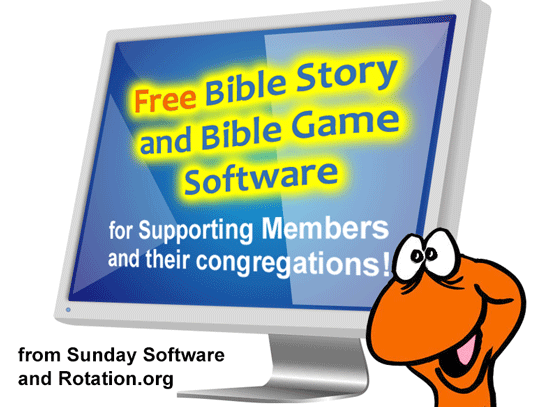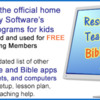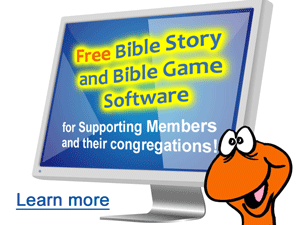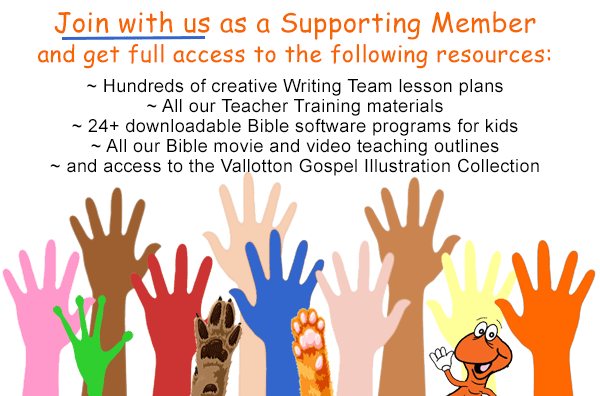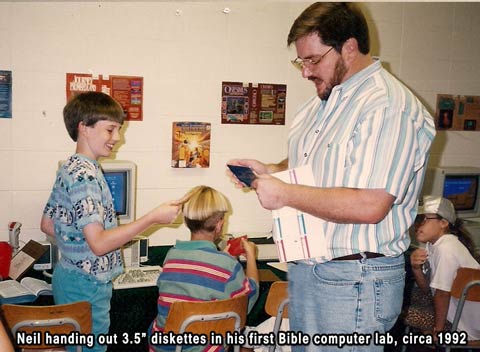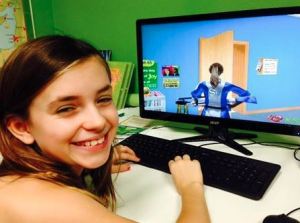Teaching with Software
A Brief "Getting Started" Article
by Neil MacQueen, Ace computer guy
2020 and 2022 Update
In 2020 I donated 18 of the Bible story and Bible game software programs I created to the supporting members of Rotation.org. Supporting members can download them for free, install them on as many PCs you need in your church, and share them within your church family for home use too! Learn more.
Though I've retired from my "SundaySoftware.com" work, our software continues to be used in Sunday Schools across North America and around the world --in part because the kids still enjoy learning this way, and because newer Windows PCs continue to be able to run good software made years ago. Thanks backwards compatibility! ![]()
Read how one church's 2022 software use is a favorite resource in their Sunday School. 

The following updated advice should be enough to get you started on the right foot. They come from my articles, seminars, book, and 25+ years of teaching with software!
The BIG Secrets:
1. We're teaching our students with the software. We're not sitting back and watching the kids watch a screen or play a game by themselves. We're not killing time trying to keep them happy (donuts are cheaper if you want to do that). I've set up and taught in many different labs over the years, and worked with hundreds who have told me their stories. I've taught with all sorts of software, with all age groups, and with a long history equipment ---and it's all still about TEACHING, being the "guide by the side."
2. Any set up or equipment that disrupts what students can use, hear, learn, interact with, or talk about isn't going to fly with me --because I'm a teacher, not (just) a techie. So that's the second big secret: recruit people who want to teach, not just tech, and then set up your equipment to facilitate how and what you want to teach with. This brief article and my software lessons posted here at Rotation.org should help you do that.
Using software in Sunday School can take many forms.
- Some churches have "labs" where groups of 2 or 3 students gather around each computer station and are overseen by a teacher "guide by the side."
- Some churches will use a single computer connected to a large screen or projector to "present" Bible software to their entire class and invite kids to take turns helping navigate. Some programs are better for this "large group" use.
- Some churches have a REGULARLY SCHEDULED computer workshop and a sustaining collection of Bible story software that matches "most" of their upcoming Bible story needs. Others use computers ON SPECIAL OCCASIONS such as when the software they own matches the story they're teaching, or when they want to focus on a certain type of computer software activity, such as doing scripture memory work, or they want to make a big splash with a fun onscreen quiz.
- In the Rotation Model, computers/software can be used as an option in a Bible Skills and Games Workshop, or as an option for the A-V (Video) Workshop. It really just depends on your setup, teaching needs, and software.
- Some churches incorporate software in their summer Sunday School to boost attendance or do lesson review using computer quizzes and scripture memory software.
You don't need to buy a new computer to get started teaching with existing Bible software. You or another teacher probably already have a PC laptop or tablet you could bring in, and certain church members with a spare PC or two laying that you could borrow (or get them to donate).
Operating System = Windows
Most of the still-available software made in the last 20 years works GREAT on Windows 7, 8 and Windows 10 --AND NOW WINDOWS 11 too! --and that's good news when you're being offered older computers. Even though I said you don't need to buy a new laptop to do this, don't be surprised when your committee or an enthused member offers to buy one for you. Sometimes, this happens after they've seen your software and how the kids are responding. Show them.
I really don't care how "old" a program is. I'm not competing with the latest version of Call of Duty on Sunday morning any more than the preacher is competing with Billy Graham or Tom Brady at 10 a.m. What I care about is engaging CONTENT and in that, much of the Bible software I've designed EXCELS (even if I do say so myself). Go download a copy of the Ten Commandments software, or Elijah and Jonah. If those two programs don't make your teaching hairs stand up, you hate computers. ![]()
Yes, there are some good Bible "apps" for kids that will run on smartphones and tablets, as well as some "creativity apps" you can download from the Apple or Google Play store. There aren't a ton of them, but some are very good. In today's "computer lab" or software use in Sunday School you'll probably end up using BOTH software and apps to match up to your teaching schedule and age group. Check out our resource page on those types of programs! 
Today's "Tik Tok" generation can make a video in 10 minutes. Only problem is, you have to open and post your kids' creation to Tik Tok to use the Tik Tok creative tools and see the results. That's a can of worms.
LESSON PLANS FOR BIBLE SOFTWARE
The Rotation.org Writing Team lessons are the best source for complete computer workshop lesson plans. I know that because I've WRITTEN most of those lesson plans (and taught them too). I've also posted lots of computer/software lesson ideas in our public lesson forums. Just look up your Bible story in the Lesson Forums or the Writing Team menu.

Why Start?
When I first experimented with software in Sunday School back in 1990, I couldn't believe how excited and transfixed the kids were with anything we put on the screen. Now here we are twenty-six years later and the kids are still just as enthusiastic. To me, that's all a real teacher needs to know to answer "why start." ⇒ Because our kids STILL love to learn with these tools.
In fact, our kids are MORE attracted these days to "learning with a device." The question is still, how well are you going to use this opportunity?
Kids do not need less screentime for learning.
They need less screentime that wastes time.
 Sunday School doesn't have the luxury of turning down attractive teaching methods. We are in a battle for our kids' attention and hearts. Teaching with software simply helps us win that battle.
Sunday School doesn't have the luxury of turning down attractive teaching methods. We are in a battle for our kids' attention and hearts. Teaching with software simply helps us win that battle.
I used to talk a lot about "how attractive" computers were to the mind, but the smartphone revolution has taken the words right out of my mouth. Now even the ADULTS are glued to screens. And yes, too much of a good thing can be a bad thing. You can teach the story of Moses with too many crafts, too many skits, and too many songs. The worst "too much" is "too much boredom."
Let's be clear about one thing: when you find something for teaching the Bible that works, run with it! If our kids loved to learn God's Word using tiddly winks, I'd recommend them. ![]()
And if anyone says their kid "already spends too much time in front of a screen," point out that you are putting the BIBLE in front of them, ...and that maybe they should reduce the amount of time they let their kids watch cat videos and use Snapchat. The Bible is more important. (And why is it that those complaining about screen-time can't seem to pull THEMSELVES away from their own cellphone?)
Those of us teaching with software do not use it all the time. We "rotate" our kids through our computer labs. This week the 3rd and 4th graders, next week the 5th and 6th. This is why you often see computers in Rotation Sunday Schools, ...because Rotation Modelers understand that there are many exciting ways to teach, and we need to bring them all to bear.
Many of the programs that Bible PC computer labs USED TO USE back in the 90's and early 2000's are now out of print. You might still see a few referenced here at Rotation.org for those churches that still own those programs (or whose references we haven't changed yet). But the 18 software programs I've donated to Rotation.org will literally give you HUNDREDS of hours of engaging interactive learning for many of the major stories of the Bible.
(Don't get me going about why our denoms haven't published good software for kids. Most don't publish ANY good media for kids because they are cheap and broke.)
Hardware and Getting Started
You'll need a Windows PC if you want to use the good free stuff here at Rotation.org that has Bible content in it. Almost ZERO Bible software or Bible apps for kids run on a Mac, and only a few decent ones run on tablets or iPads.
Windows 7, 8, 10 and 11 are good to go. Most of the software I made was designed for what are now "older" computers, or as I like to say, "the kind your members have to donate." ![]() Anything less will likely be under-powered for certain graphic-intensive programs
Anything less will likely be under-powered for certain graphic-intensive programs
If you are buying new: an inexpensive Windows PC is the computer of choice, hands down. But keep in mind that good used Windows-based computers are surprisingly easy to find. Talk to your members and local tech community. Very sorry to say that little exists for Mac anymore, and very little software or "apps" of any depth or quality exist for tablets/pads right now.
If you want to just use Bible apps on tablets, your content choices are going to be limited, especially for older students. Check out the discussion about those types of programs and hardware.
How many computers do you need?
If you're going with a "lab" concept where you have dedicated space for two or more computers for your group, get enough PCs so that you have 2.5 kids per computer. ("2.5" as in sometimes 2, sometimes 3, and yes, even sometimes 4 kids per computer).
If you're going with a "presentation" approach of having one computer that a group of kids will be viewing and/or using together, get one good laptop and an LCD projector or extra large extra monitor. Connect a mouse to the laptop to make it easier for the kids.
Laptops are portable and inexpensive these days, but their screens are too small for 3 kids to share. It's a viewing angle thing. They also aren't as durable. If you can't get enough computers, adjust your schedule to reduce the number of kids using the computers at any one time.
I can't stress the "numbers" issue enough. Too many kids and too few computers or tablets and not enough teachers "by their side" is a recipe for failure. I like to sit right with my kids at the computer. We call this the "guide by the side" model.
What about the internet?
There is very little on the internet you should let your kids browse freely to find, but there's some good content YOU the teacher may want to show them. I do like using YOUTUBE videos in my teaching, and Rotation.org's lesson forums have lots of links to them. But watching a video in the computer lab doesn't need a bunch of computers. It's "interactive" learning that needs a mouse and computer. I will sometimes pull up a Google Map or photos of Bible Lands on the internet. Just gotta watch out for those belly fat ads ![]()
Printers? Operating System? Networking?
Networking to a printer is a good idea if you plan on doing some printing. That said, many computer "labs" discover they don't need or don't want to print (due to the cost of ink).
Sharing an internet connection is not a bad idea if you're going to be browsing, but otherwise the computers do not need to be hooked up to each other. If you're using tablets, you'll probably need an internet connection as some stories on the apps have to be downloaded AS YOU USE THEM.

Here's a lab I set up in previous church. The tablecloths were heavy vinyl. The noodles were decorative but also helped with sound reduction (some). We eventually put a divider between the two tables and that helped with sound-spray a lot. We also decorated with tiki grass bunting and that softened the room too (as well as making it look more fun).
Computer "Lab" Layout:
Other than your teachers, your layout is the single biggest factor that will affect the quality of your lab's learning experience. Simply put: too close and too loud is too bad.
Space is an issue. Computers give off heat and sound. I recommend placing them on long Sunday School tables, far enough apart so the kids can use them as workstations without crowding other computers.
If you don't have enough space, have fewer computers and fewer kids. It's as simple as that. This isn't like video where you can pack them in, or art where you can tear the paper in half. And don't solve space issues with headphones please... keep reading for my diatribe on that ![]()
Do not put computers at right angles to each other. Pick walls that are opposite of each other. Sound diminishes over distance. Put in a rug, and put your discussion table/chairs in the middle to break the sound. Put your computer speakers on extension wires so you can pull them close to the kids and thus, keep the volume down. Ideally, you want speakers that have a KNOB. They are easier to reach than the Windows volume control.
If you're simply using ONE COMPUTER to "present" software to your class, then you just need a solid table for your laptop or PC and a blank wall (for projection) or place for your bigger monitor. Headphones?
Headphones?
NO. And if you use them, don't tell me. ![]()
Or better yet, tell me how a Sunday School teacher's comments get heard when the kids are wearing headphones? I teach "by the side", not standing against the wall. See my Teaching Training Pamphlet posted in this forum for more about that.
About the Teachers
They are your computer lab's key to success.
- Recruit teachers who ENJOY software, and know their way around a lesson plan. "Techies" who can't teach are worse than teachers who can't tech.
- Don't overload them with too much equipment or kids. Less is usually more.
- Remind them that they are the "guide by the side" when they lead the class. This is not a "turn it on and step back" medium.
- Preview software with your teachers, and make sure they have teaching materials that go with the software. I have also posted dozens of computer lab lessons at rotation.org.
Tip: Look for men or women who won't touch your other workshops, but relate well to kids and are handy with computers. Invite them to come teach WITH YOU. I'm a big believer in this "apprentice" model for training, especially in the computer lab where NONE OF US grew up learning with software. (Okay...look for women too! I'm just saying that many men are hiding from your program and might come out for computers. That's been the experience.)
 Print the "Teaching with Software" pamphlet. It has a number of tips for teachers.
Print the "Teaching with Software" pamphlet. It has a number of tips for teachers.
About the Age Ranges
No doubt about it, the 3rd through 6th graders are the EASIEST age to use software with. Most of the software is broadly aimed at children who can read and type. That said, most of us also have non-readers and pre-readers rotating into our computer labs. I've written a lot about how to handle them in a lab and with certain types of software. Basically, it comes down to this: younger children can do anything the older kids do, if you give them help. This is where your "Bible Lab Buddies" come in...teens with a heart of service.
My Bias: I think our older children benefit more from this medium than younger. Our 3rd through 8th graders need a reason to keep coming to Sunday School. Computers rock that reason! They are in the midst of forming an opinion about the church. Give it a computer lab boost. So if your schedule or budget forces you to make a choice...lean toward the older kids. On the other side, I prefer to have Jr and Sr Highs as my teaching assistants than as my "students". Jr Highs would give Jesus himself a hard time.
I hope this "Getting Started" overview helps. I appreciate the opportunity rotation.org has given me to share my passion for teaching with software. I hope you enjoy the 17 programs I have created and now donated. I had a blast making them. See them here.
<>< Neil
P.S. The photos in this article come from the Sunday School Computer Workshop that I set up and taught in during an interim associate pastor position in Bradenton FL. We themed and called it our "Bible Surf Shack."
Who is Neil MacQueen?
Neil is a Presbyterian minister specilizing in Christian education. He is one of the founders of the Workshop Rotation Model and Rotation.org. A year after launching the Rotation model in his church, he began experimenting with computers in the classroom. In 1996 he created Sunday Software Inc. A year later he started Rotation.org which eventually became an independent non-profit run by volunteers. In 2015 Rotation.org's leaders invited Neil to become the site's webmaster, and later its lead writer. In 2020 Neil donated his software as a thank you to Rotation.org's supporting members.

